1lumen selects and reviews products personally. We may earn affiliate commissions through our links, which help support our testing.
LOOP SK01s Skywalker review
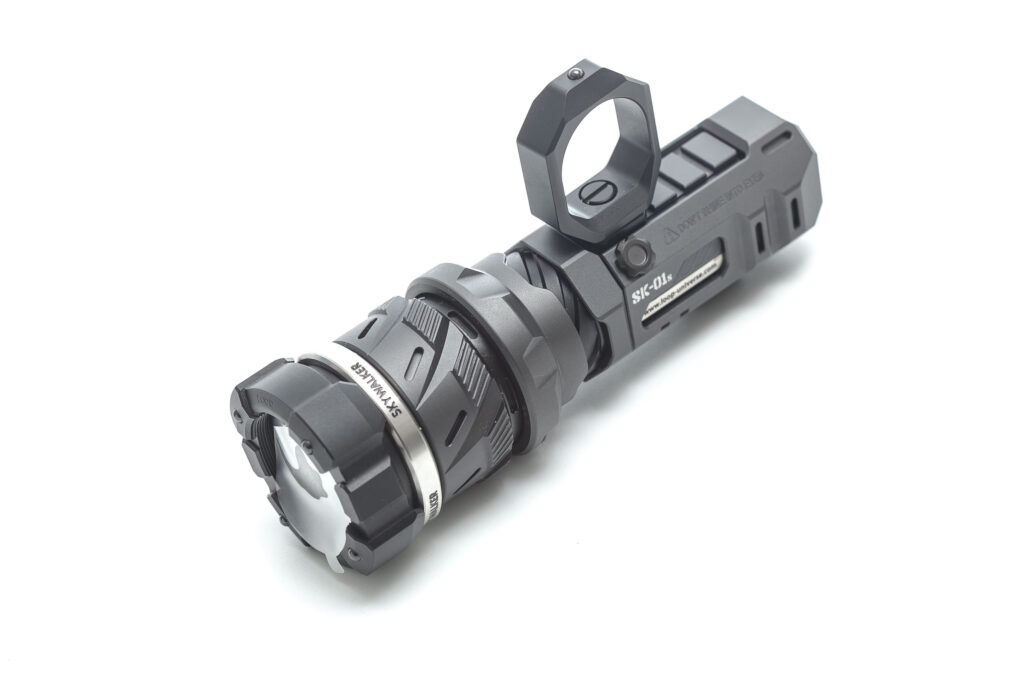
LOOP SK01s Skywalker specifications
| Brand/model | LOOP SK01s |
|---|---|
| Flashlight category | Fidget / LEP |
| LEP | LEP (shine through) |
| Max. output | 910 Lumens |
| Max. beam distance | 1,600 meters |
| Max. beam intensity | 640,000 cd |
| Battery config. | 1*18350 |
| Onboard charging | N/A , but battery has USB-C |
| Modes | 4 |
| Blinkies | N/A |
| Waterproof | IP67 |
| Review date | February 2023 |
Introduction:
Loop who? Loop Universe, the new kid on the block!
Bruce, the owner of Loop Universe has enough flashlight experience under his belt, to know what designing flashlights means. And even though this is their first flashlight to date, it’s directly a very unique one.
The SK01s Skywalker is a zoomable LEP (which stands for Laser Excited Phosphor) which is by itself already quite unique, it also has 3 fidget actions built into it, as well as a unique lighted tail switch.
And when you read their website, they explain the following: “They strive to blend the universe elements into flashlights which is their other common interest, design and manufacture stylish, playable flashlights.”
And yes, that is exactly what they did, building a stylish, playable flashlight. And that’s what the focus of this review will be about.
Package quality.
Loop Universe clearly knows how to design stuff. Their packaging is pretty slick, and of good quality, and the most interesting part is probably the manual. It’s so different from any major flashlight brand, in that it’s black with an interesting design.
This is what’s inside the package:
- The flashlight: Loop SK01s Skywalker
- 18350 USB-C rechargeable battery (1100mAh)
- USB-C charging cable
- Spare o-ring
- Metal washer
- 3 little springs
- Manual: uniquely looking, unlike any other manufacturer
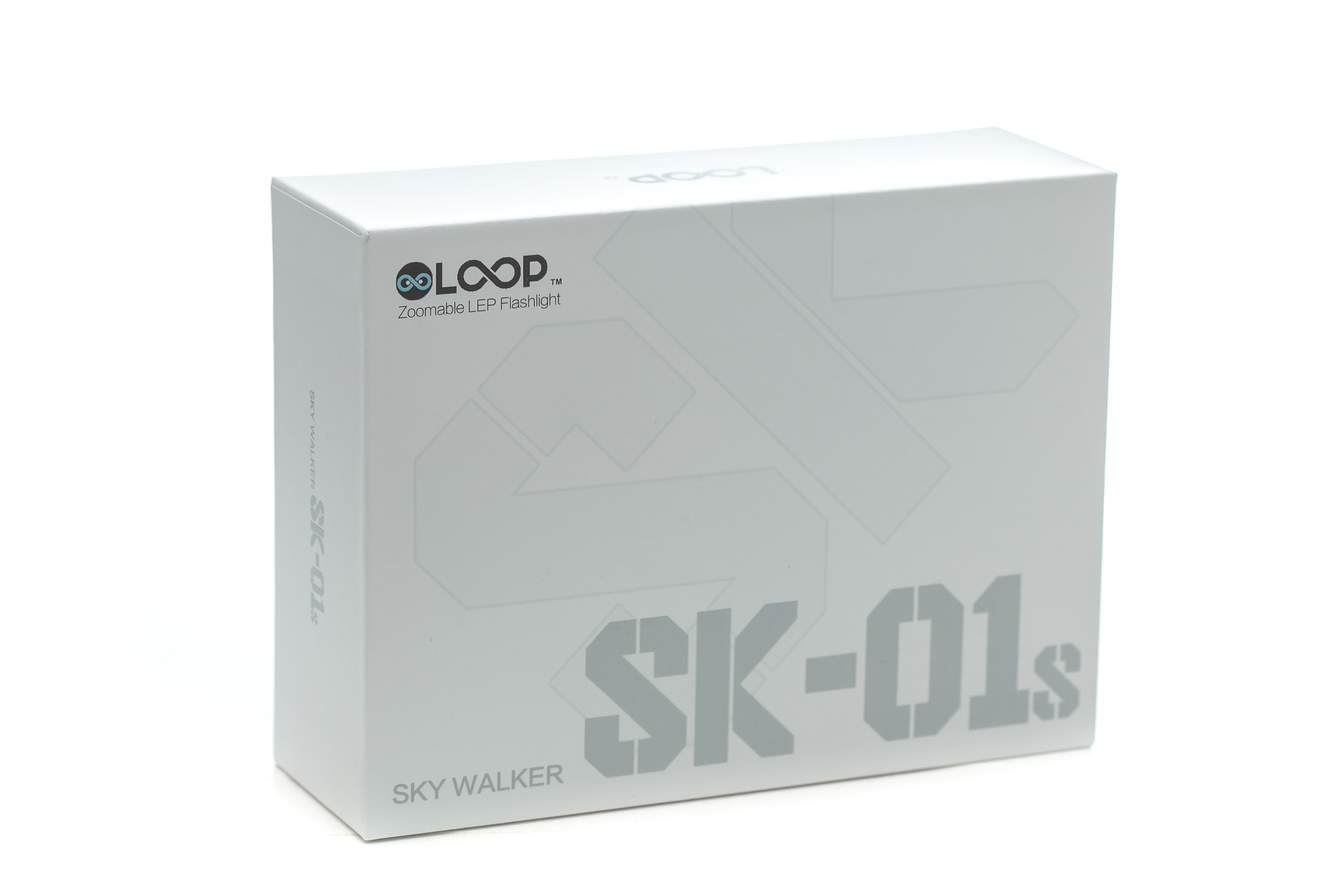
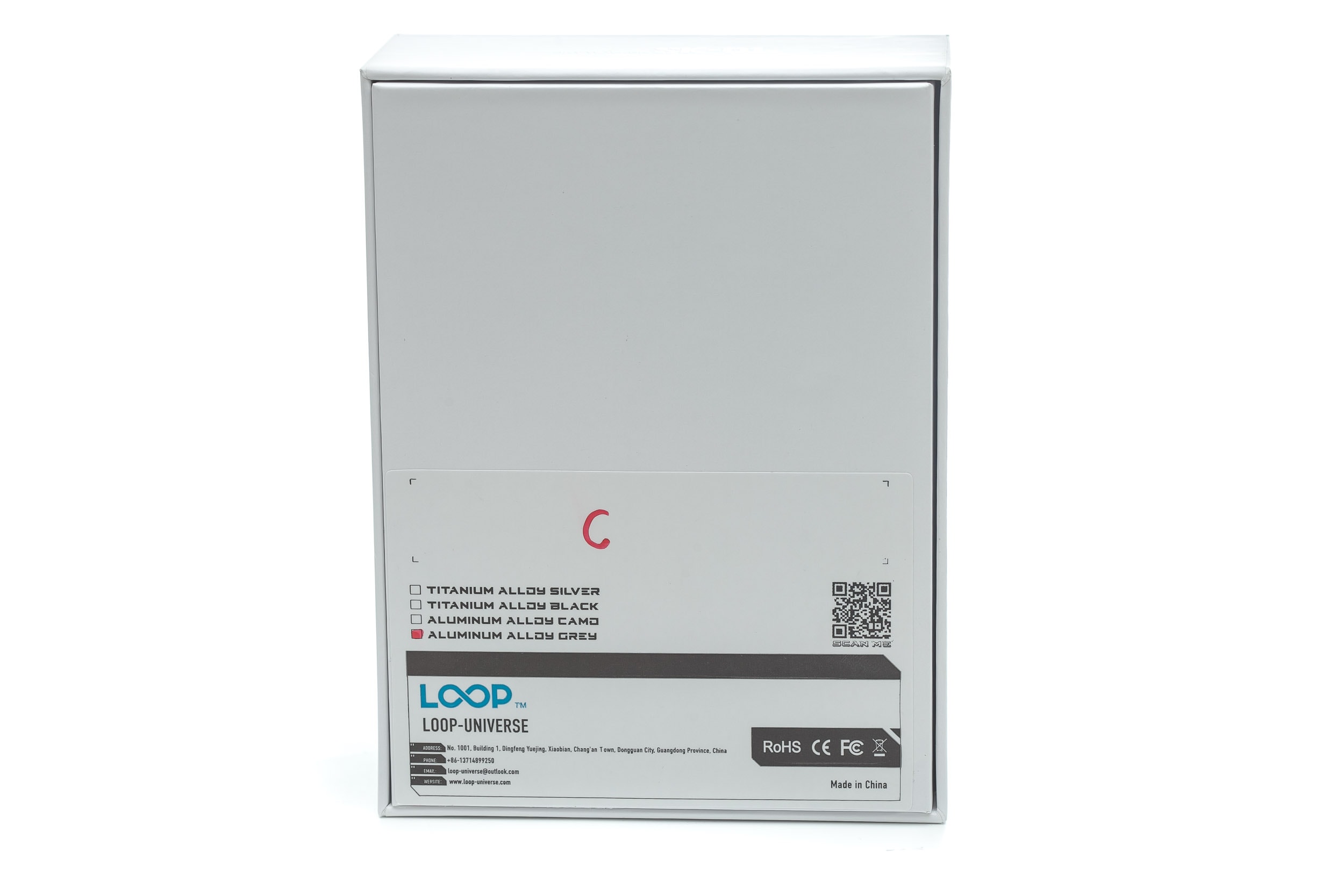


Flashlight in use
I don’t think you are supposed to pocket-carry this flashlight.
Why?
Because you’ll get dust and dirt inside the ball bearings or other moving parts of the flashlight. And soon your toy will become useless. And that’s something you really want to avoid.
The ring, which is one of the spinning (fidget) parts, is designed to fit comfortably in your hand. Its size is big enough for my index finger or middle finger to pass through. This way, it provides a secure grip, with my thumb resting on the switch, and with a quick swing, go from the overhand position to the underhand position without using both hands.
And the other way to utilize this ring, is simply by spinning it. And that’s what most people will probably use it for.
On top of this ring, as well as on the bezel, you can find a nitride ceramic ball, which are supposed to be used for an emergency, like breaking glass. I would be very careful doing this because you might cut your finger badly if you do so with the one on top of this ring.
And if you don’t like the position of the ring, you can move it along some rails, toward the tail-end of the flashlight. You just need to loosen the screw a bit, and move it toward the back.
If you think that spinning 1 ring isn’t enough for reducing your stress, you’re lucky. The SK01s has a 2nd ring that can be spun. It sits right behind the ring that is used to focus the beam (zoom), and spins for many seconds.
And the zoom-ring itself is another thing you could play with, even though it doesn’t spin, you can twist it in both directions. But on my copy, this ring doesn’t turn as smoothly as an average zoom mechanism found on other lights. When I try to turn the ring clockwise, the battery tube unscrews and breaks the contact. On 1 side this is actually a good thing, because it won’t lose focus easily!
I would suggest zooming with 2 hands, with 1 hand holding the bezel instead of the battery tube!
And the last fidget feature is the bolt action movement of the battery tube. It has a lock mechanism and will jump back into place when you unlock it. When it is extracted, it also features as a sort of lockout for the switch, because the switch isn’t protruding anymore.
This is quite a fidget LEP toy!

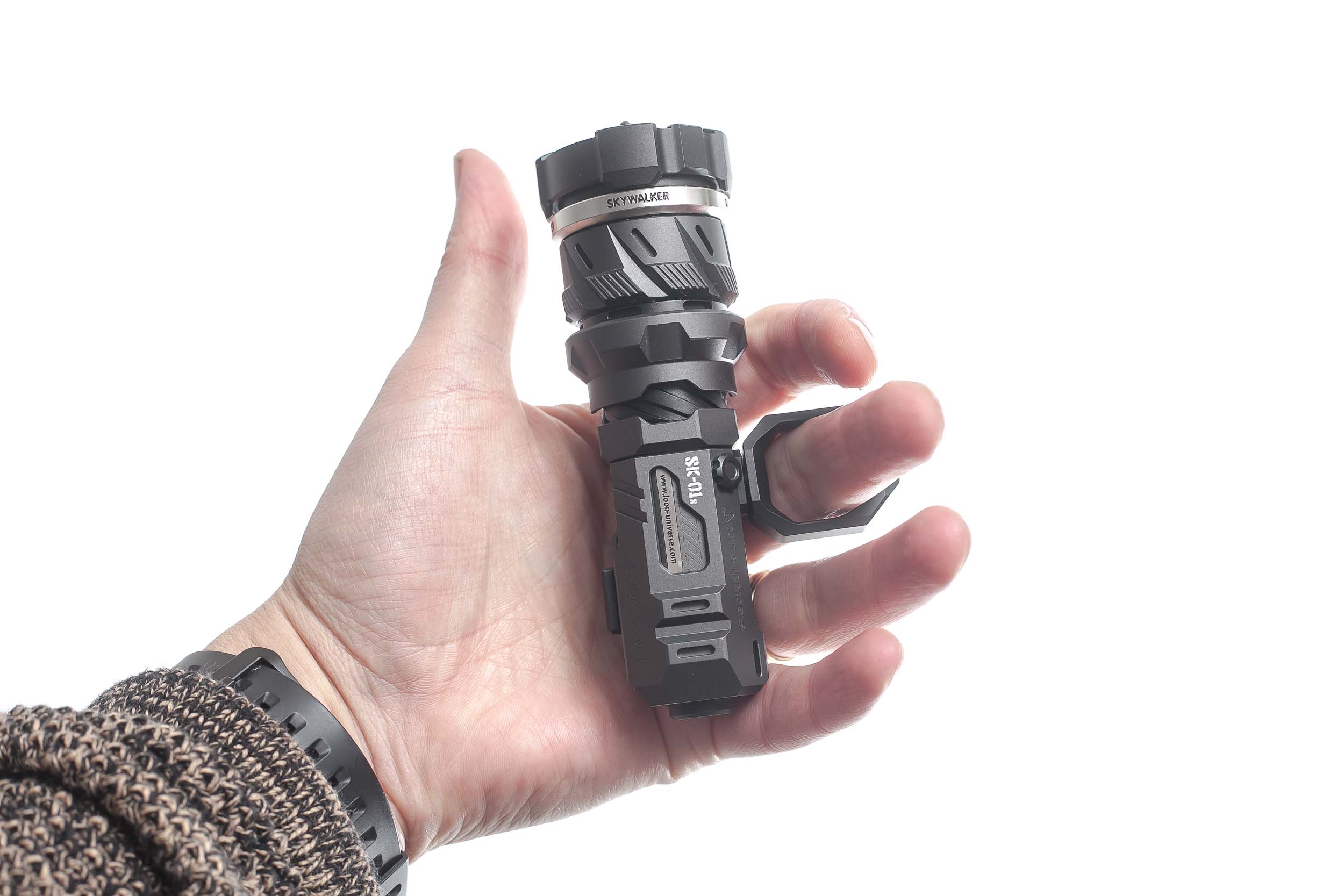

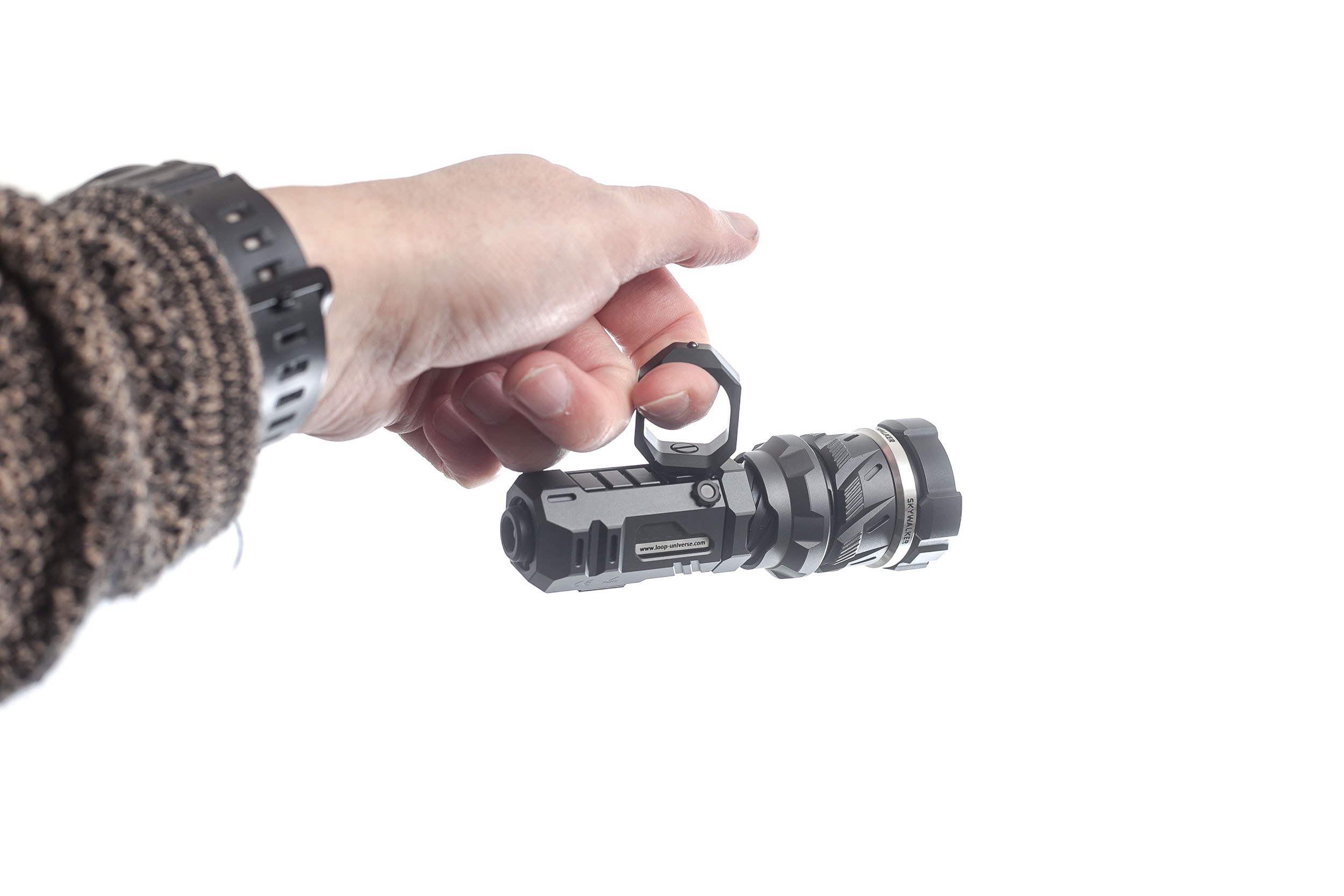
Build Quality and Warranty
In the previous section, I mentioned the stiffness of the zoom ring, so that could be an issue, but it could also be just something that needs some use before it runs smoothly.
I also notice that there were some discolored spots on the driver’s contact ring. This ring is supposed to have a gold color, but mine has some discolored spots.
For the rest, the flashlight’s anodization looks pretty good without any blemishes to be found. The bezel has a different color, but that’s a design feature, together with the stainless steel ring with the name SKYWALKER engraved into it.
The threads are anodized, but not lubed too well. So, you better add some lubrication when you get it.
Warranty:
The warranty card says the following: This warranty card is the guarantee to enjoy the warranty service. We offer 5 years warranty for the product, battery excluded. Please offer well-filled warranty card to help us fast response to your warranty demand.


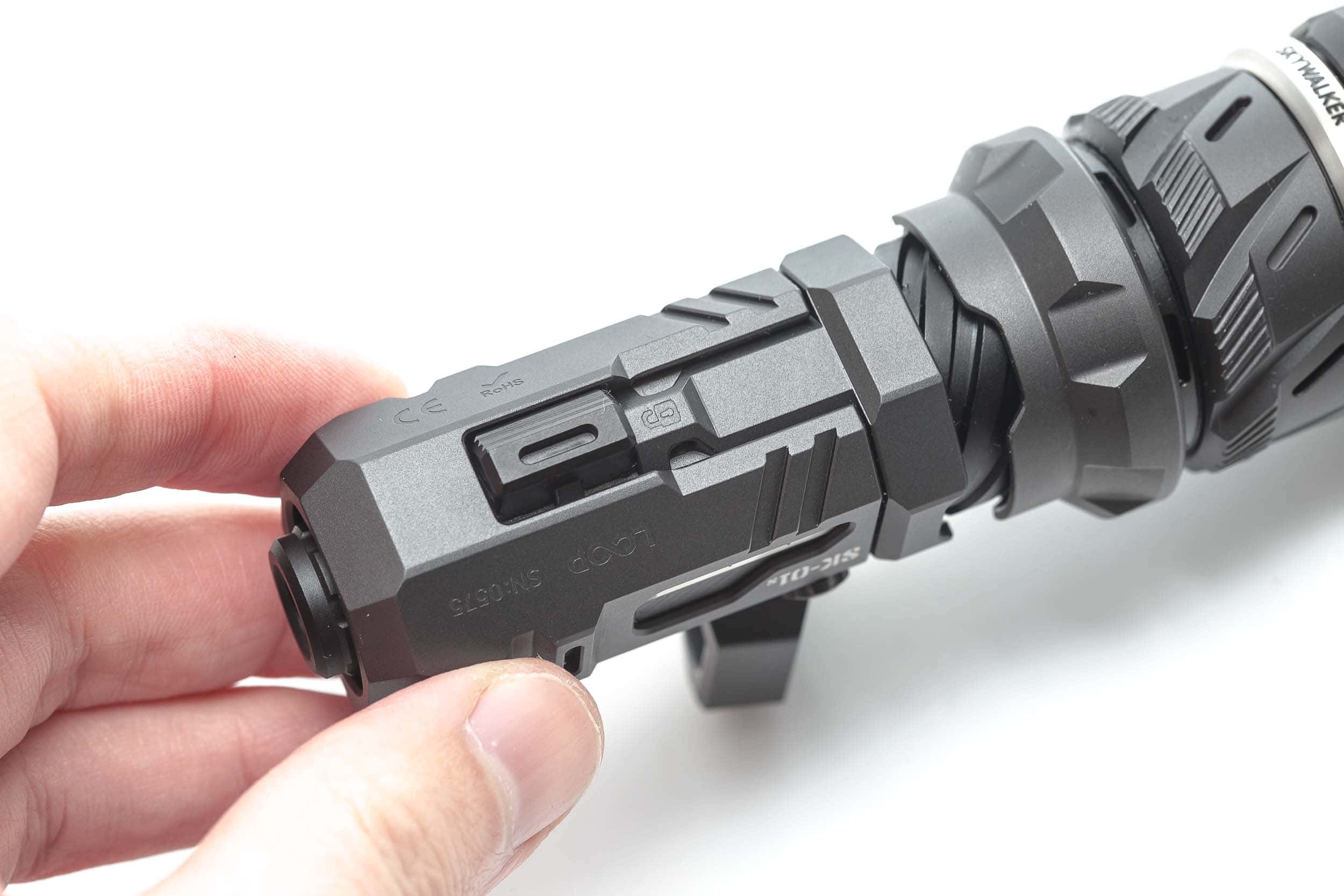

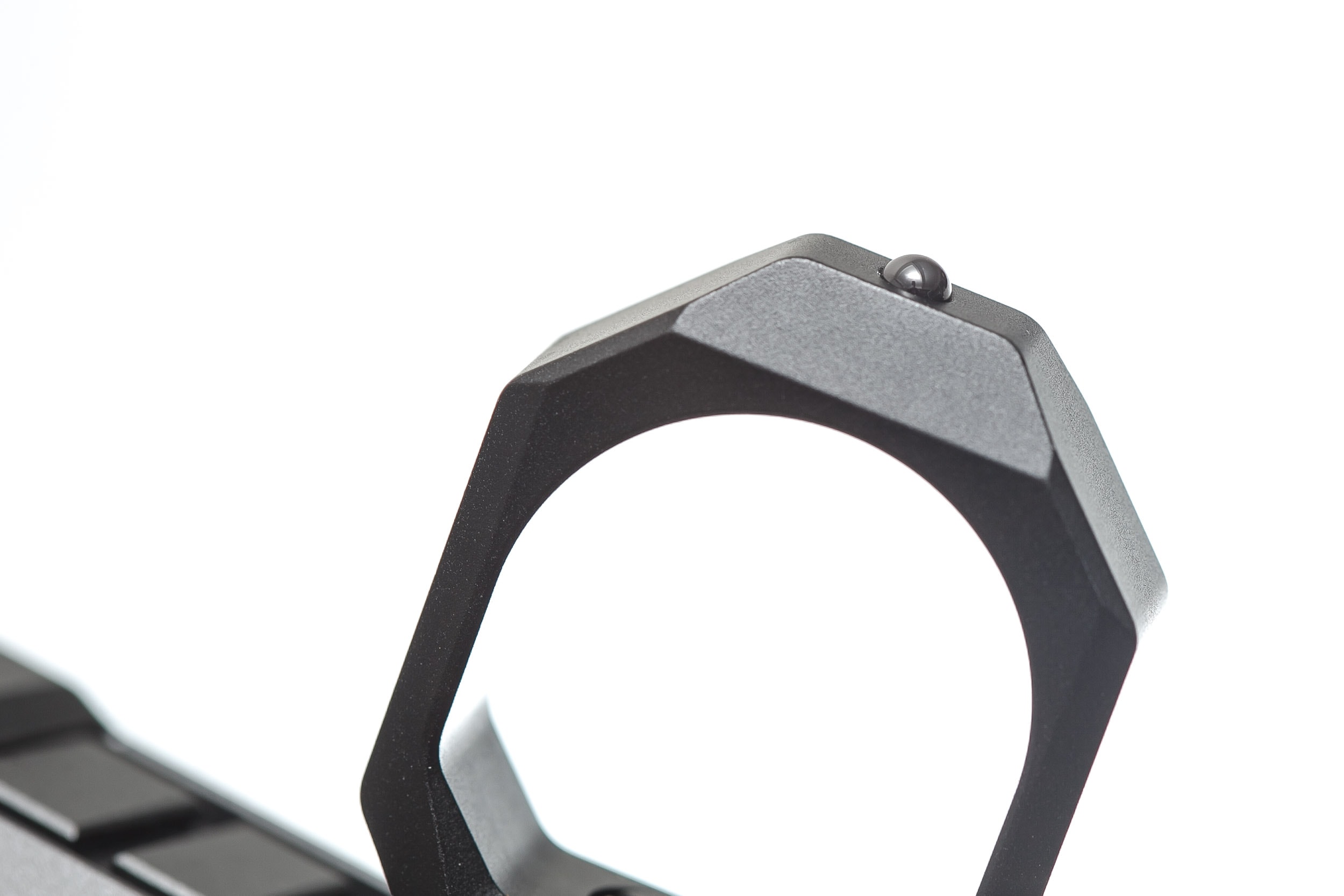
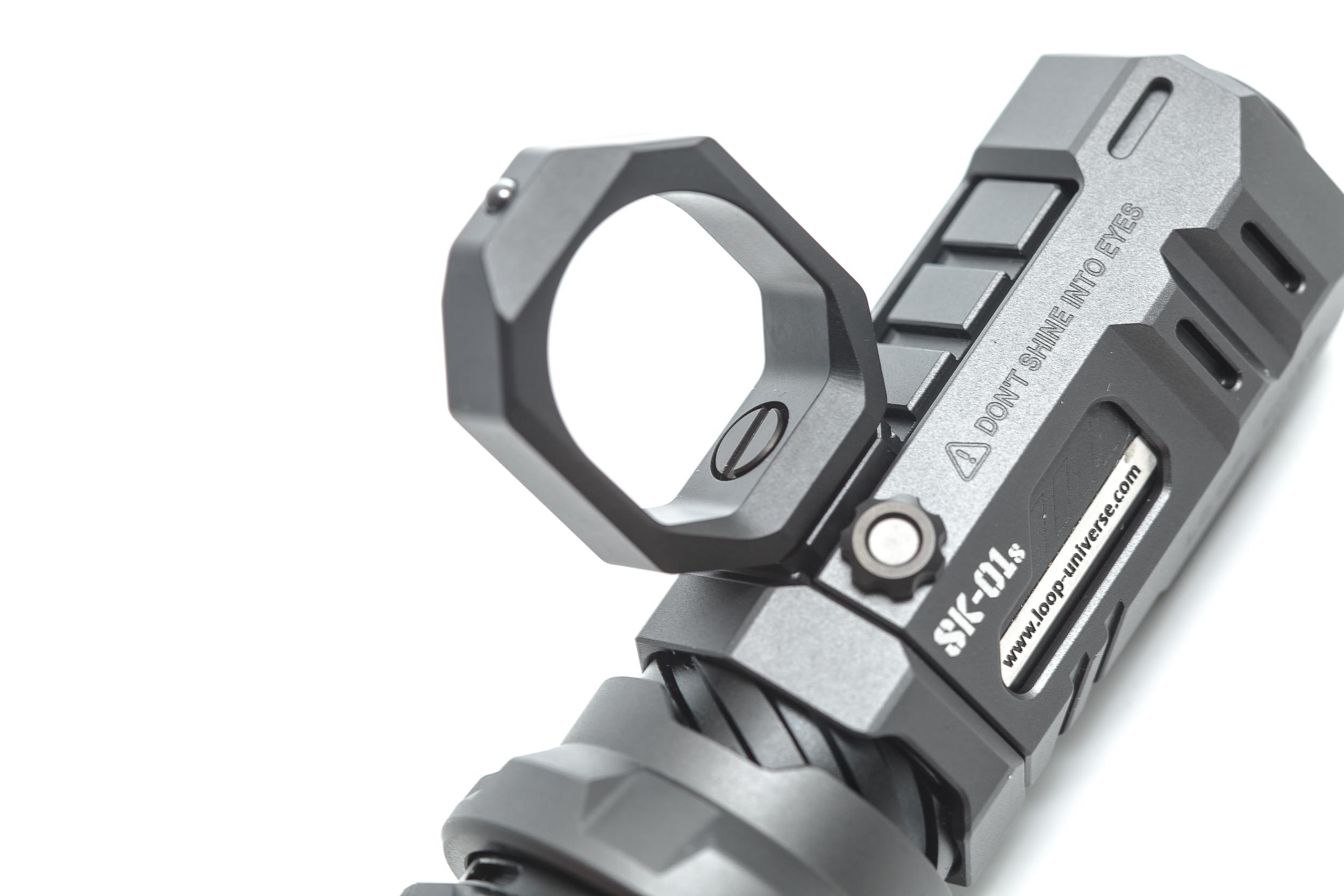
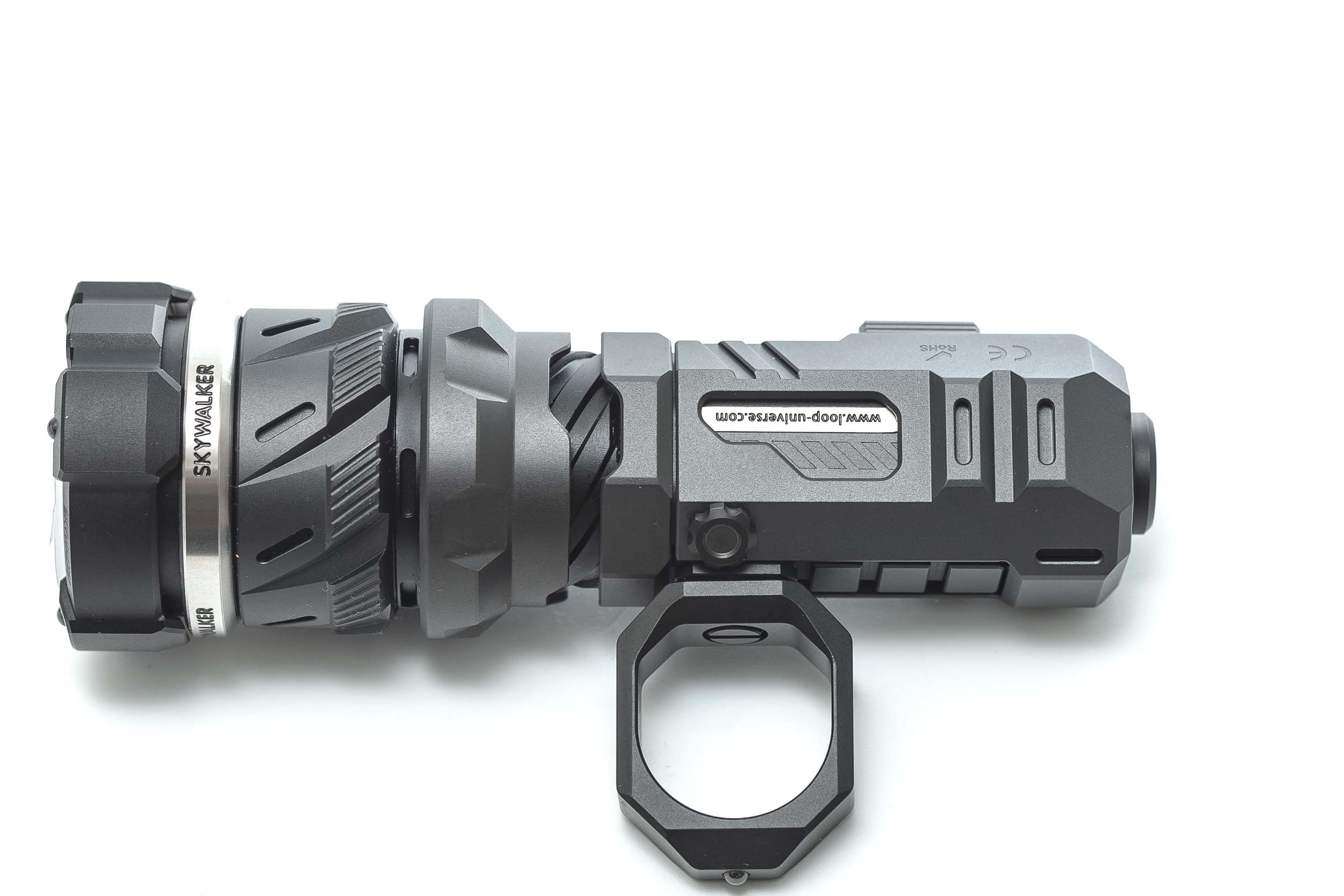
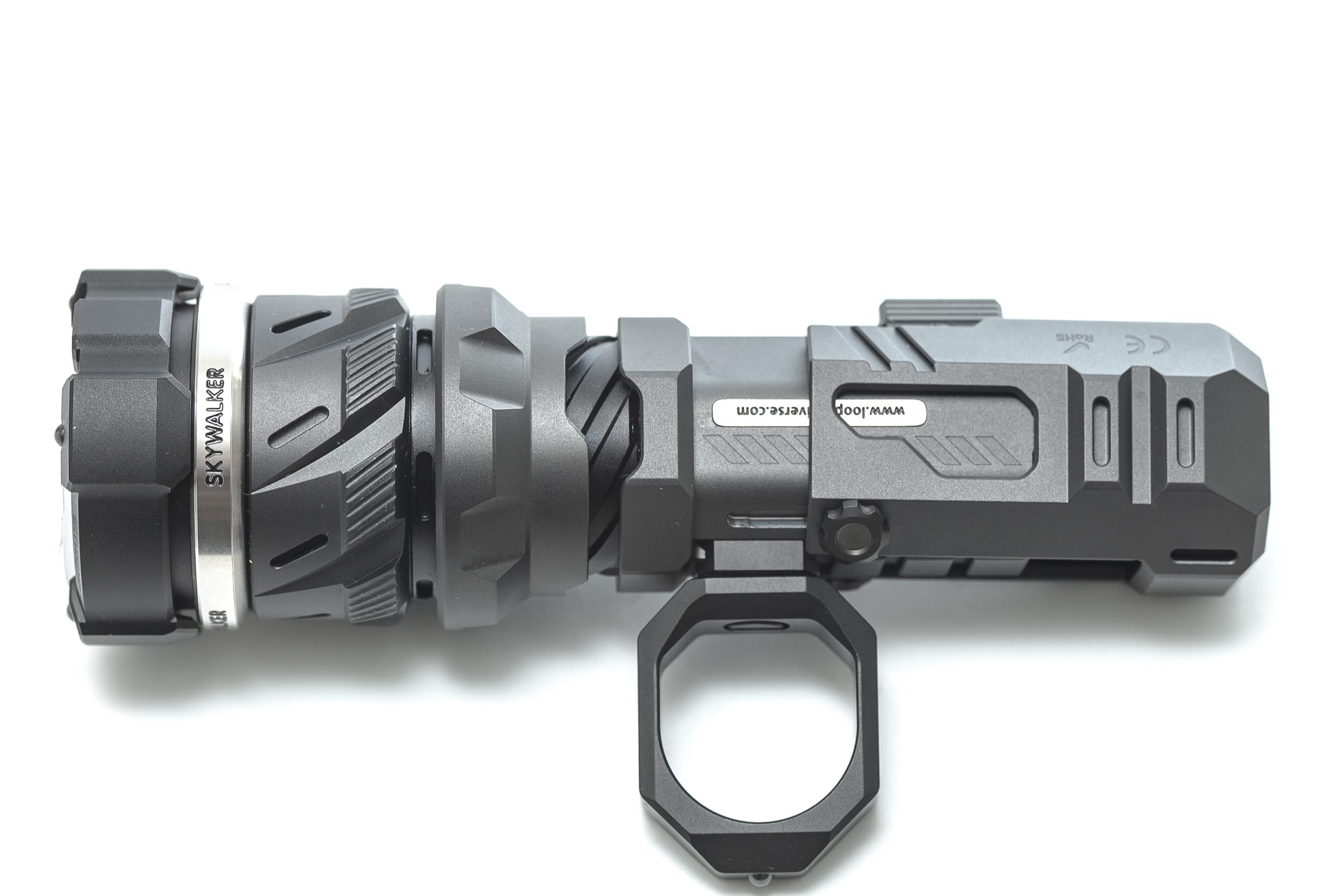
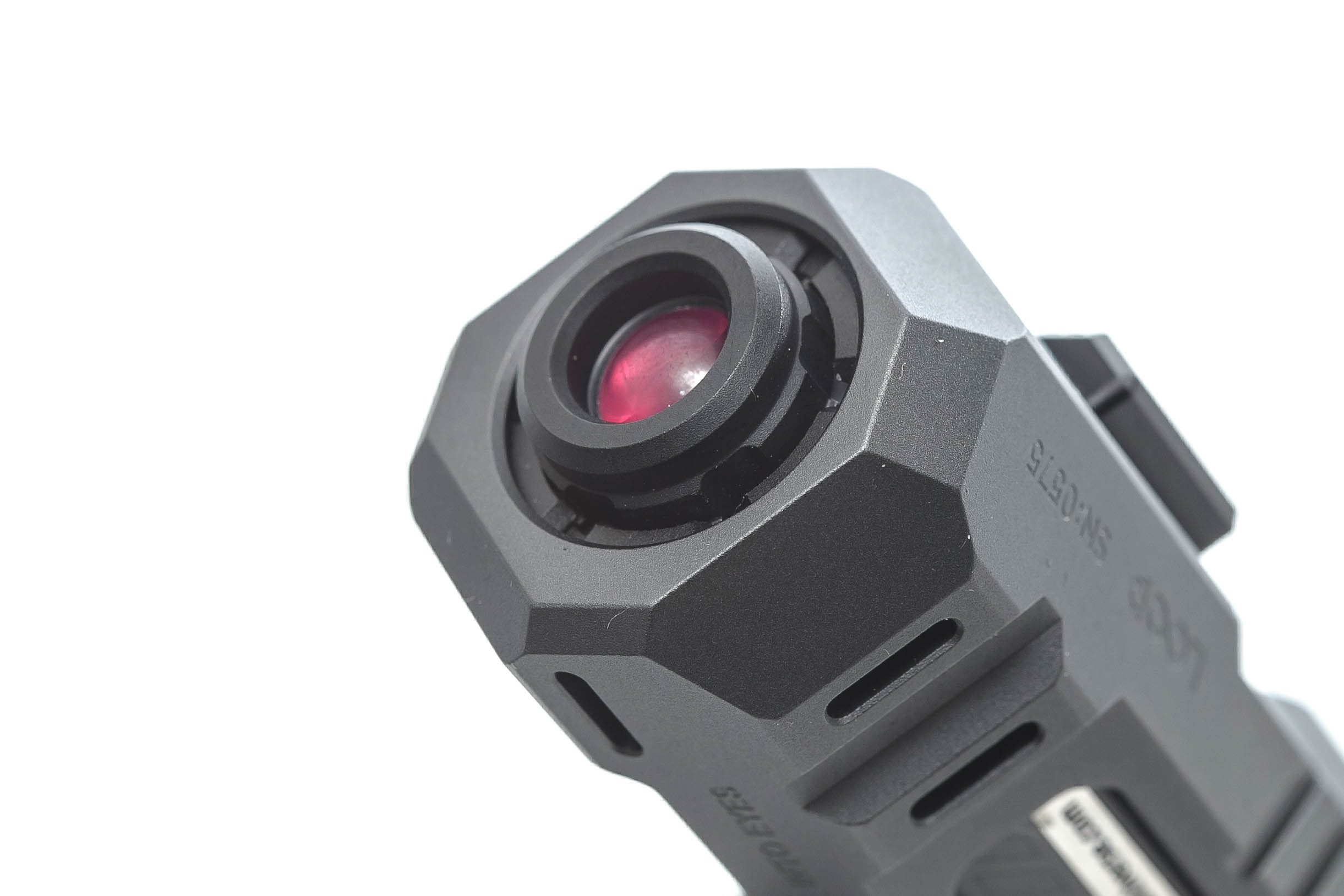
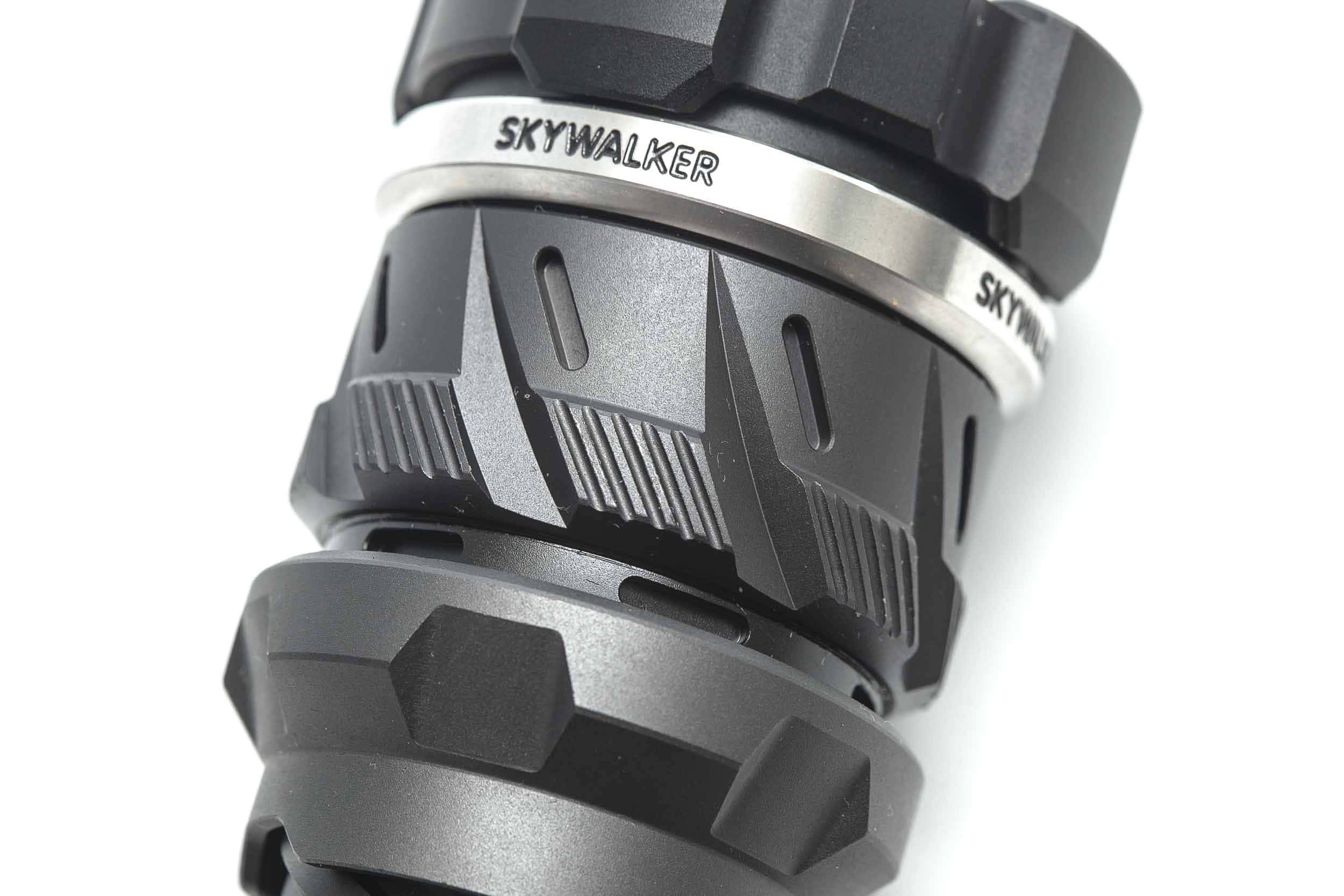
LEP, Lens, Bezel, Beam, and Reflector
In the introduction I already mentioned the light source to be LEP instead of LED.
Edit: after producing the LEP SK01S, Loop Universe has added an LED version as well. For this one, check out Nick’s Loop SK01S LED review.
At the moment there are 2 types of LEP modules. The oldest, and still the best performing, is the mirror-type LEP, where the blue laser shines onto a layer of phosphor via a mirror, which turns the blue light into white/yellow light like an LED.
The second type, which this SK01s is using, is the shine-through type, where the laser shines through a translucent layer of phosphor which turns the beam into a LED-like beam. The benefit of this type is the much smaller LEP module. Instead of a 2cm diameter, you only need less than 1 cm.
Another thing that is important is the use of protective glass in front of the convex lens. So, if you drop the light, or scratch it, you can easily replace the protection lens for cheap without having to find the specific convex lens made for this light.
That being said, the SK01s doesn’t have a protection glass in front of the convex lens, so that’s another reason why it’s not really meant to be carried in your pockets.
The bezel has a darker coating that the flashlight and has 4 ceramic balls, which are supposed to help with breaking glass. I don’t fully understand the reason behind this, for this flashlight, but it’s a nice feature. In case you are indoors, and there is a fire or something, you are more likely to break the glass than with your bear hands.
I am not going to share the Spectro measurements because nobody buys an LEP flashlight for its beautiful tint and high CRI. At least, not yet.
One of the most interesting things is the zoom feature.
On the inside of the light, you see a ring mentioning the divergence in degrees, rated as 2.8 degrees to 18.2 degrees. I don’t really know how to test this, so I’ll leave it as is. You can see the images below to get a feeling on the ‘zoom characteristics’.
The beam is pretty white, and doesn’t have the blue halo effects seen on mirror-type LEP flashlights.
But one thing I noticed while testing at 20 meters, is some strange purple spots in the beam. I have never seen that before. Almost UV-like. It looks like there are tiny spots of phosphor missing where the blue laser just shines through…?
Quite a strange experience. You wouldn’t notice when shining it onto something holding the light, or on something at a close distance. You’d have to put the light down, shine it onto something that is about 20 meters away, walk to that object and look carefully at the beam.
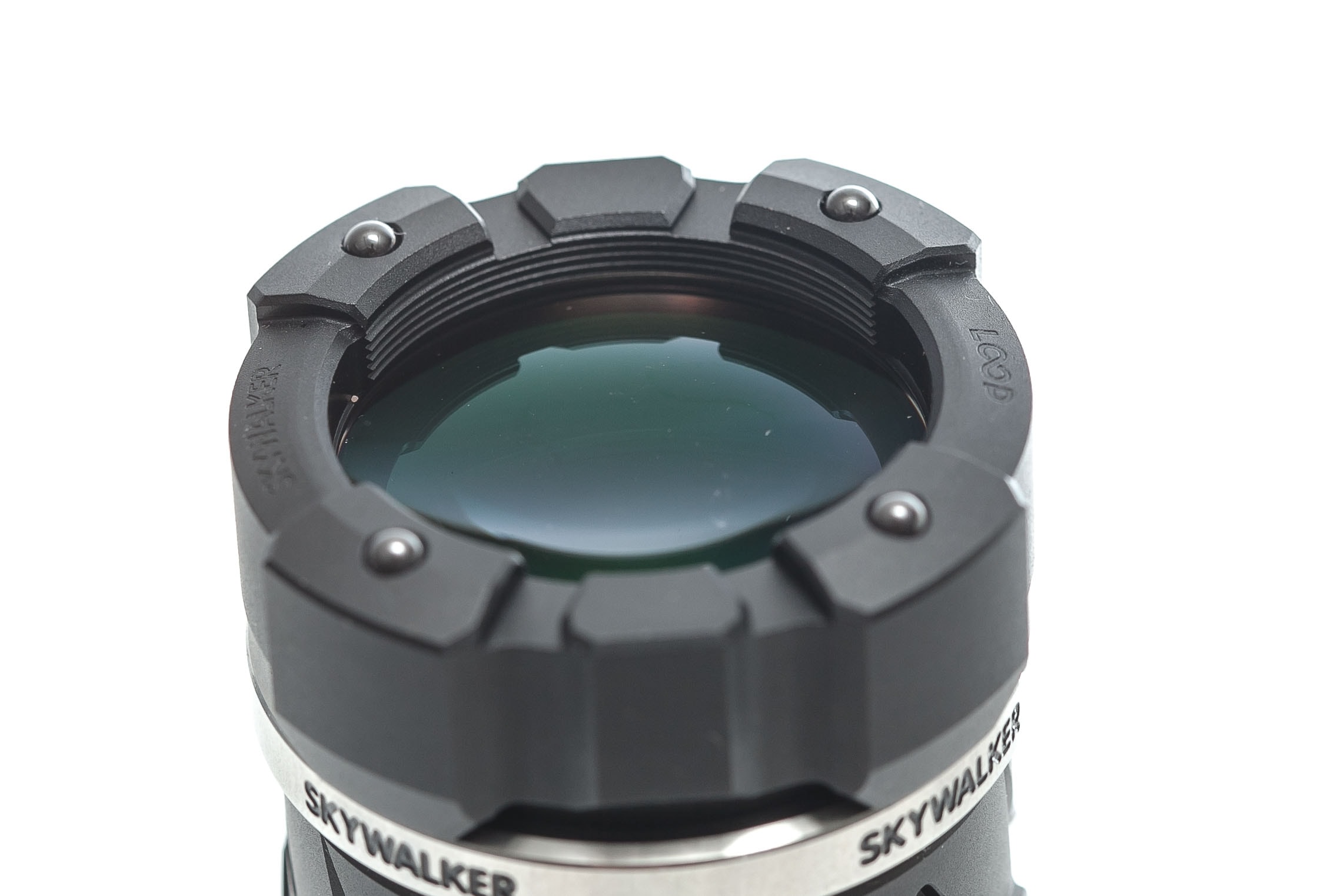

Dimensions and its competition
Dimensions:
| Millimeters | Inches | |
|---|---|---|
| Length | 127 mm | 5.0 in |
| Bezel diameter | 43mm | 1.7 in |
Dimensions are rounded to the nearest millimeter, and to the nearest tenth of an Inch.
Weight:
| Weight in grams | Weight in oz. | |
|---|---|---|
| Without battery: | 228 g | 8.0 oz |
| With battery | 253 g | 8.9 oz |
Weight is rounded to the nearest gram, and to the nearest tenth of an Oz.
LOOP SK01s Flashlight comparison
Size compared to other LEP flashlights
Group 1 small 18350 LEPs, from left to right: Lumintop Thor II, Loop SK01s, Lumintop Thor I
Group 2, small LEPs, from left to right: Lumintop Thor II v2, Mateminco FW2, Amutorch BT35, Loop SK01s, Lumintop Ant Man, Lumintop Thor 1, Lumintop Thor 4.
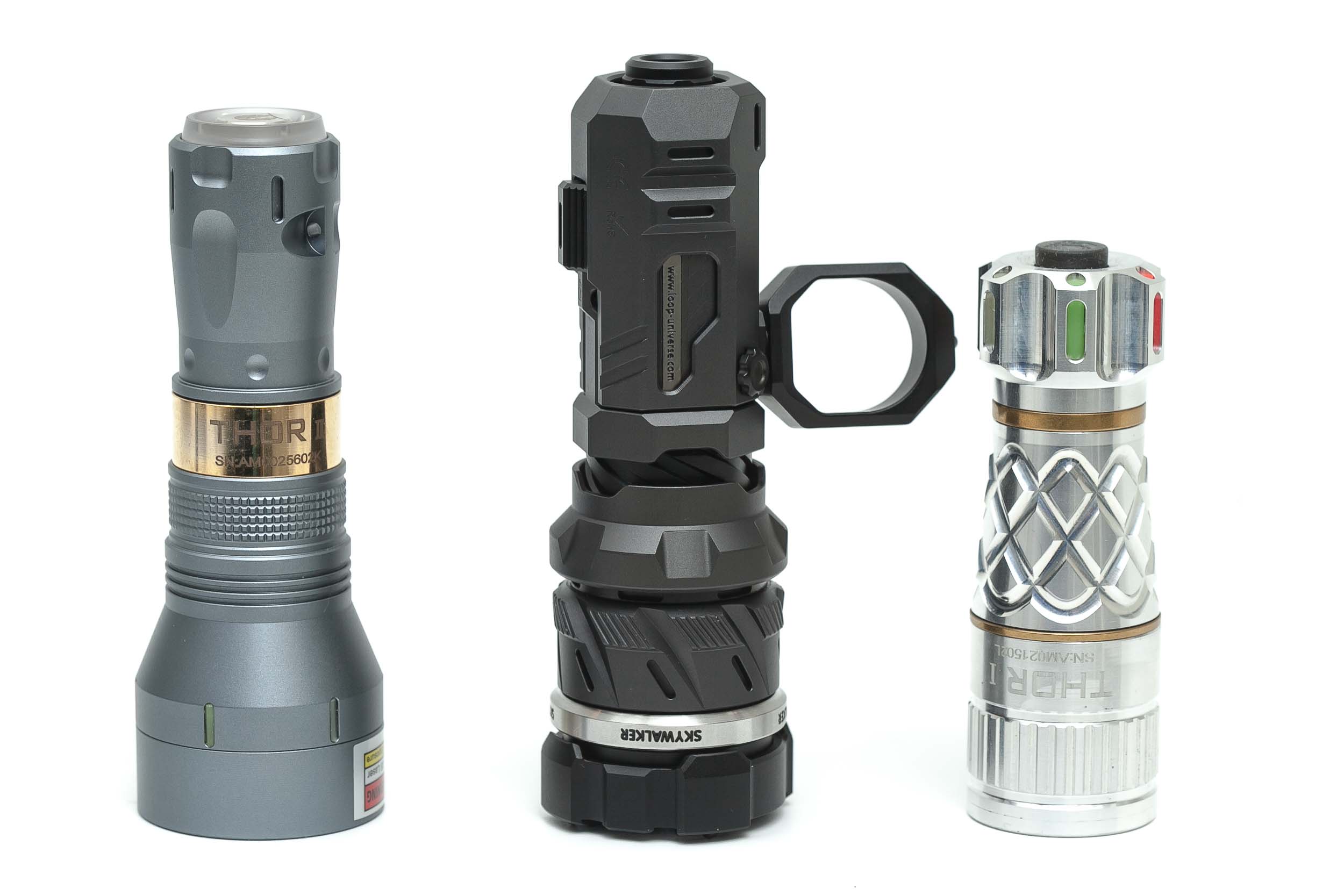
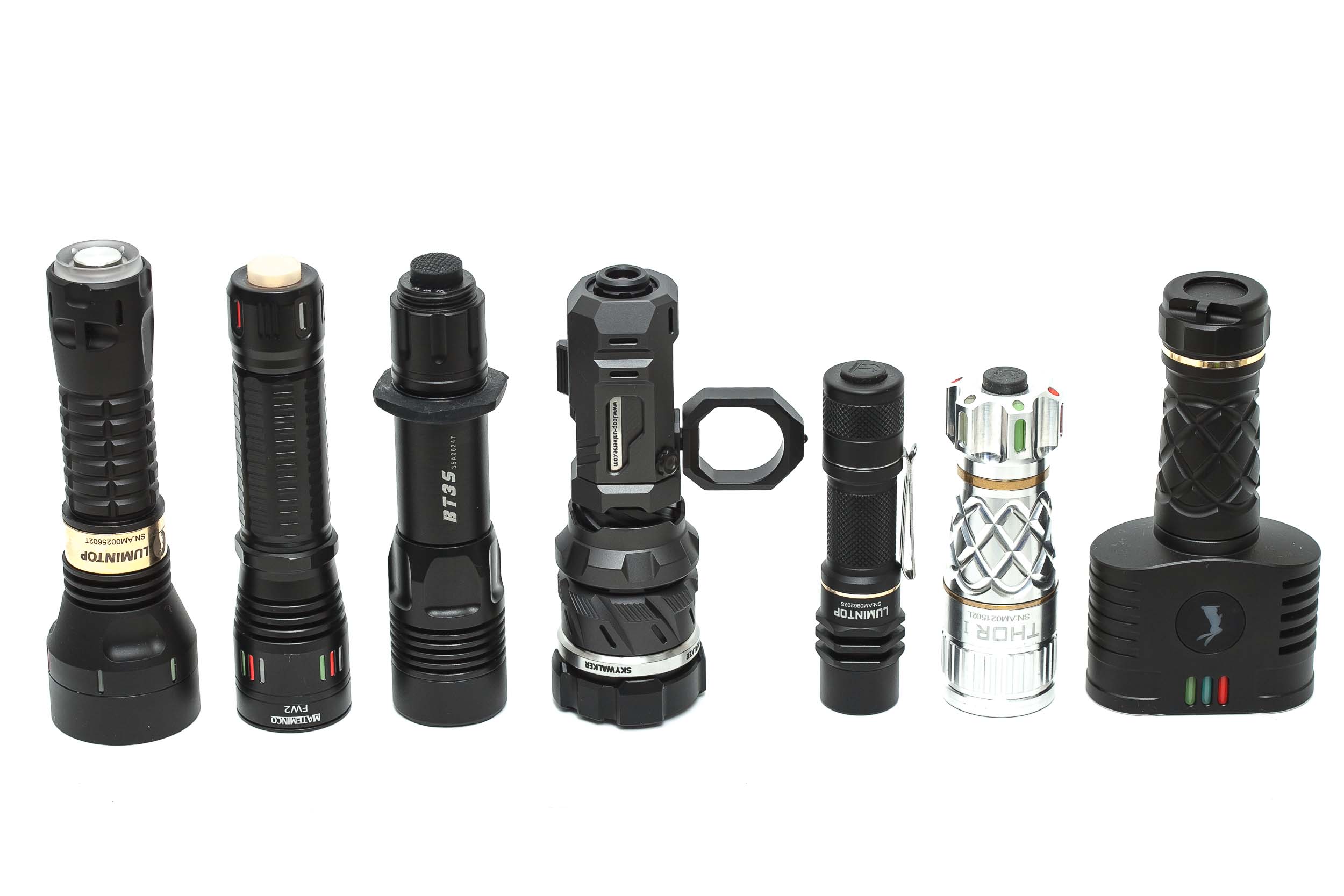
LOOP SK01s UI : User interface and driver
The KS01s has a relatively easy UI, with the use of an e-switch. The switch itself is pretty quiet.
Available main modes:
- Eco, Low, High, Turbo
Available special modes (blinkies):
- Strobe
From OFF:
- Single-click: to last used mode (mode memory)
- Double click: Turbo
- Triple-click: Strobe
- 4 clicks: activates/deactivates electronic lockout mode
- Press and hold: Eco mode
From ON:
- Single-click: turns off
- Double click: turbo
- Triple-click: strobe
- Press and hold: switch between Low and High (there is no medium mode)
Shortcuts:
- To Turbo: double click from on/off
- To Eco mode: long press from off
- To Strobe: triple-click from on/off
Mode memory:
- Yes, without Turbo and Eco mode
Blinky modes menu:
- Yes, only strobe. Do a triple click from on/off.
Low battery warning:
- Maybe, but I didn’t notice it.
Lock-out mode:
- Yes, 4 clicks from off will activate the lockout mode. The lights in the tailswitch will do some dancing to show you got it locked out. To unlock, you have to do 4 clicks and WAIT. The tailswitch lights will do some dancing and then turns the light on. This is unlike other flashlights that just turn on directly after you click 4 times.
PWM:
- Not visible by eye
LOOP SK01s Charging and batteries
The SK01s runs off a single 18350 battery, which they included in the package as well. The battery itself shows a capacity of 1100mAh, and has a USB-C port for charging.
And because of the USB-C charging port, the battery is quite a bit longer than an average, non-protected, 18350 battery. Fortunately, the SK01s also works with one of those. And I tried to see if something happens when I hit the flashlight on my hand, but it didn’t skip modes nor turned it off.
Charging the battery goes to about 1.4A at 5 watts or about 7 watts. The total charging time is between 1 hour and 8 minutes and 1 hour and 14 minutes. I measured the charging time twice. The end voltage is about 4.16V
Of course, you can also charge it in a normal battery charger, in case you prefer that.
I then tested the capacity of the battery with my SkyRC MC3000 charger and set the discharge current to 500mA, and the end voltage at 2.85V.
The total discharged capacity was 1033 mAh, as you can see in the following pictures.
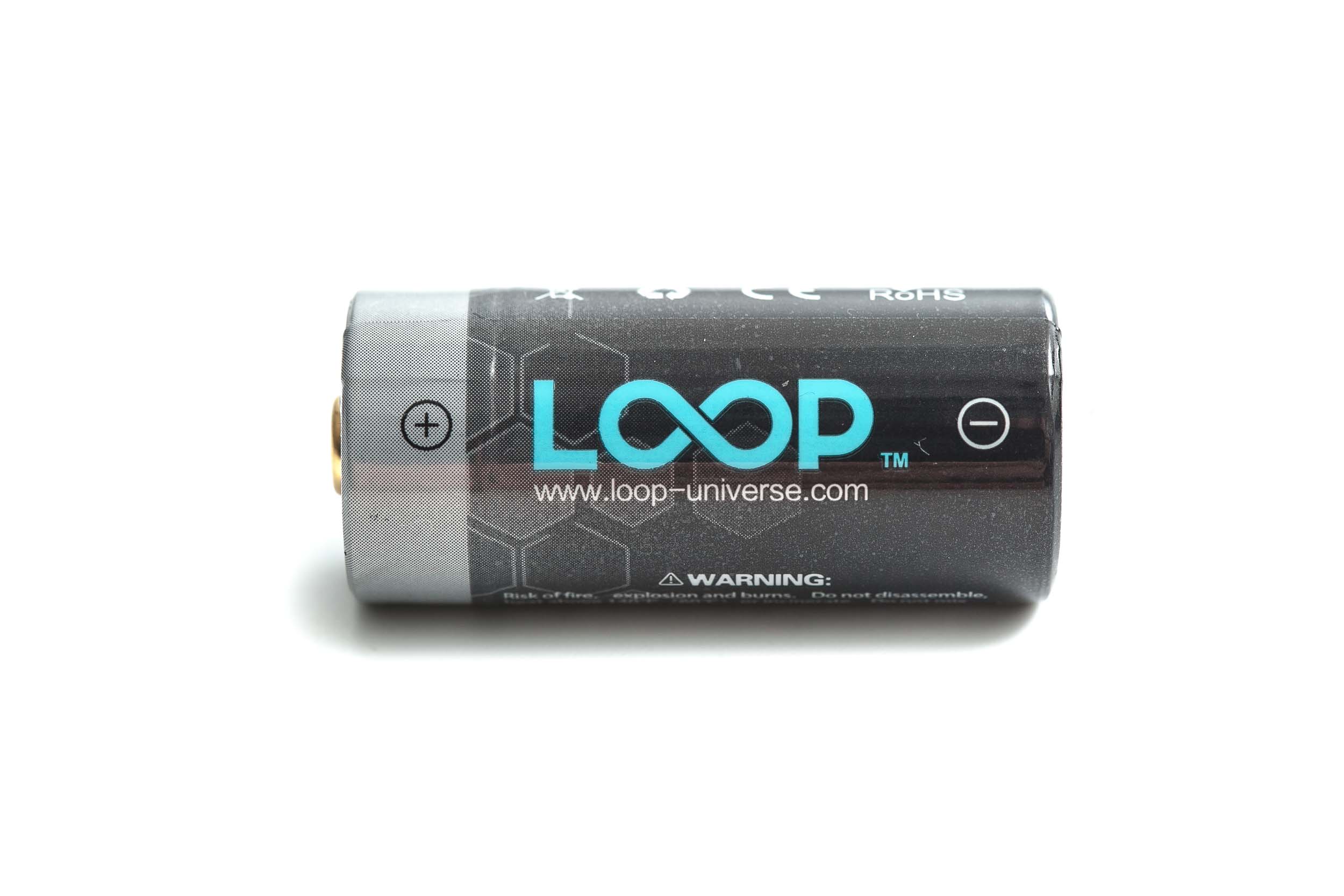

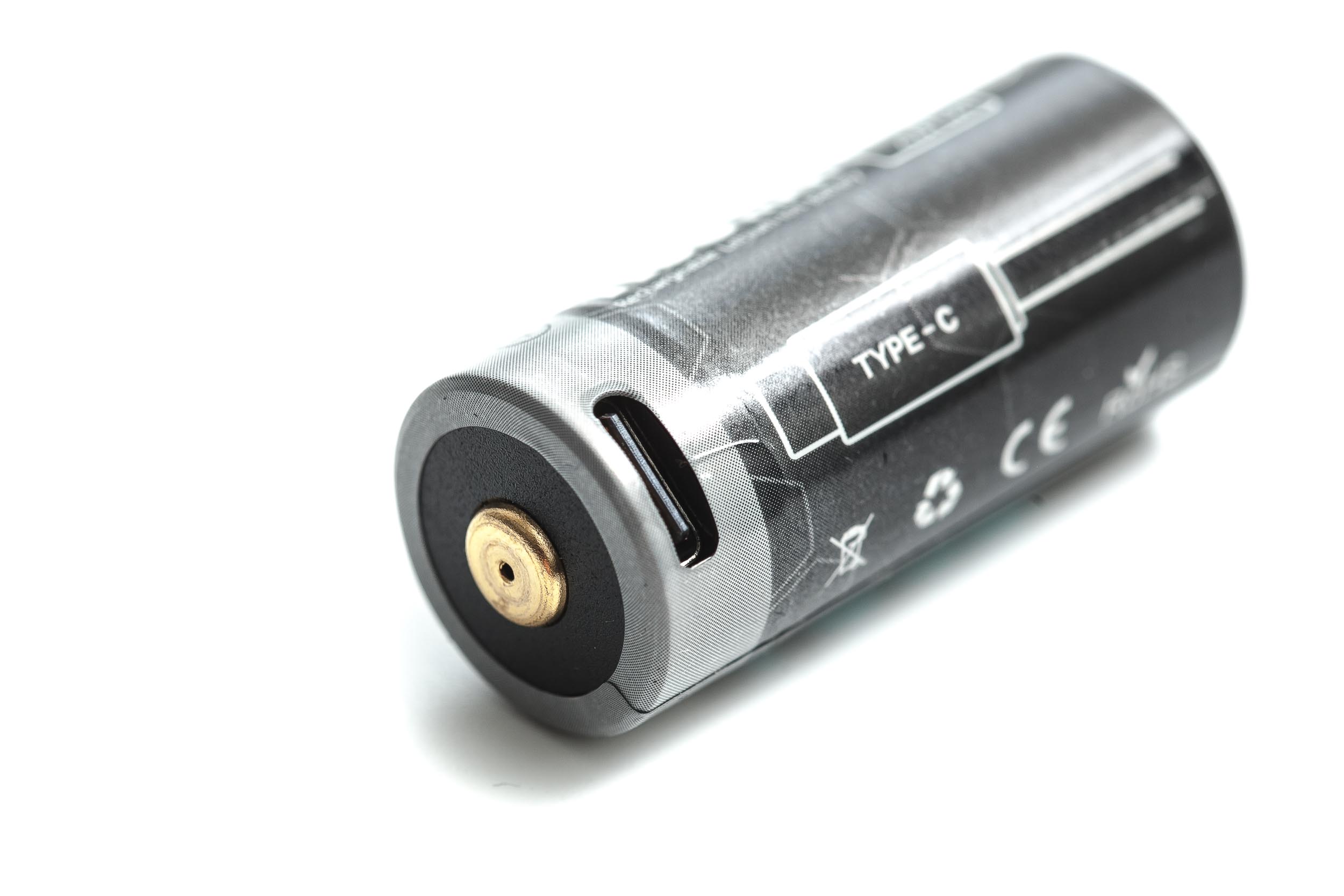
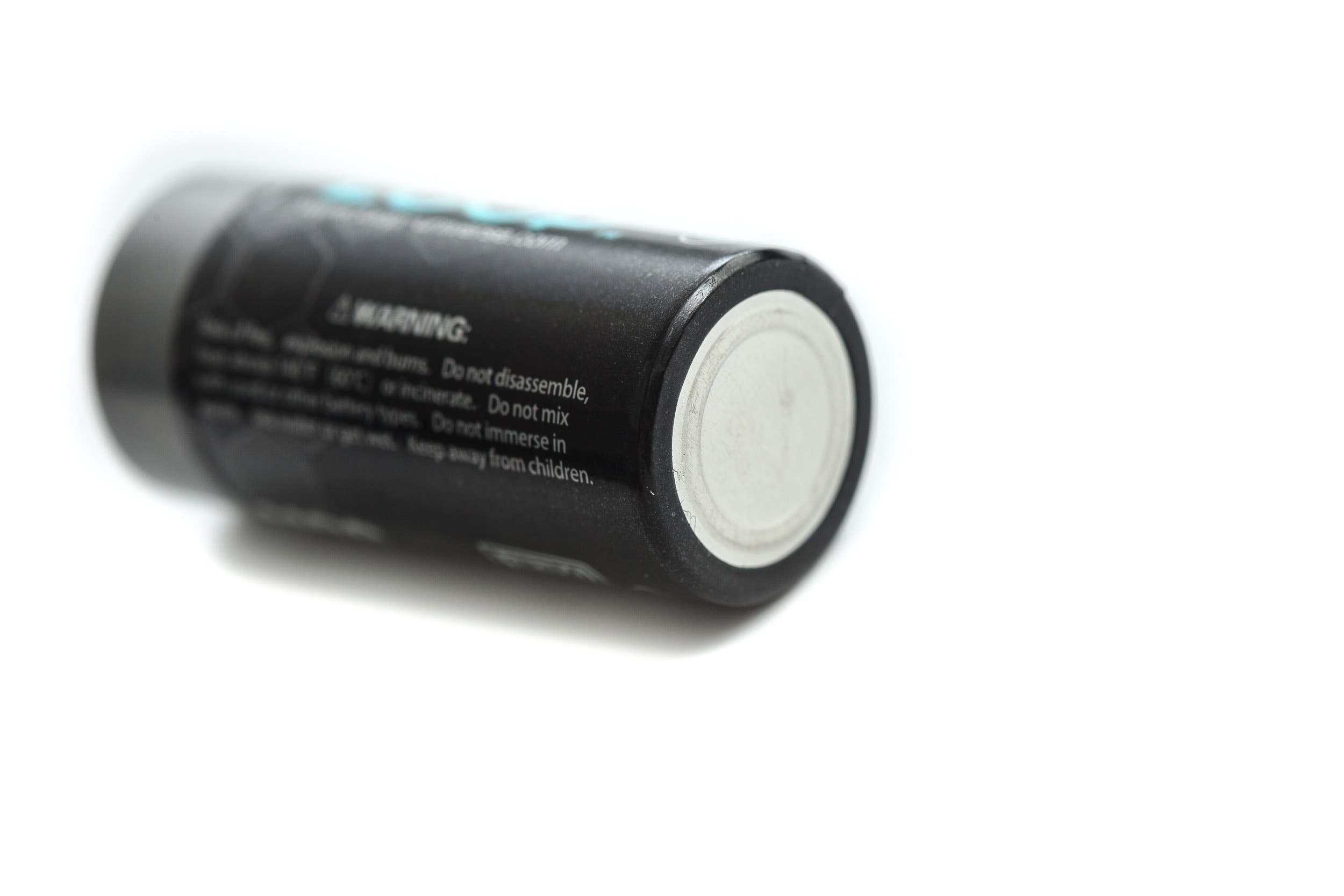
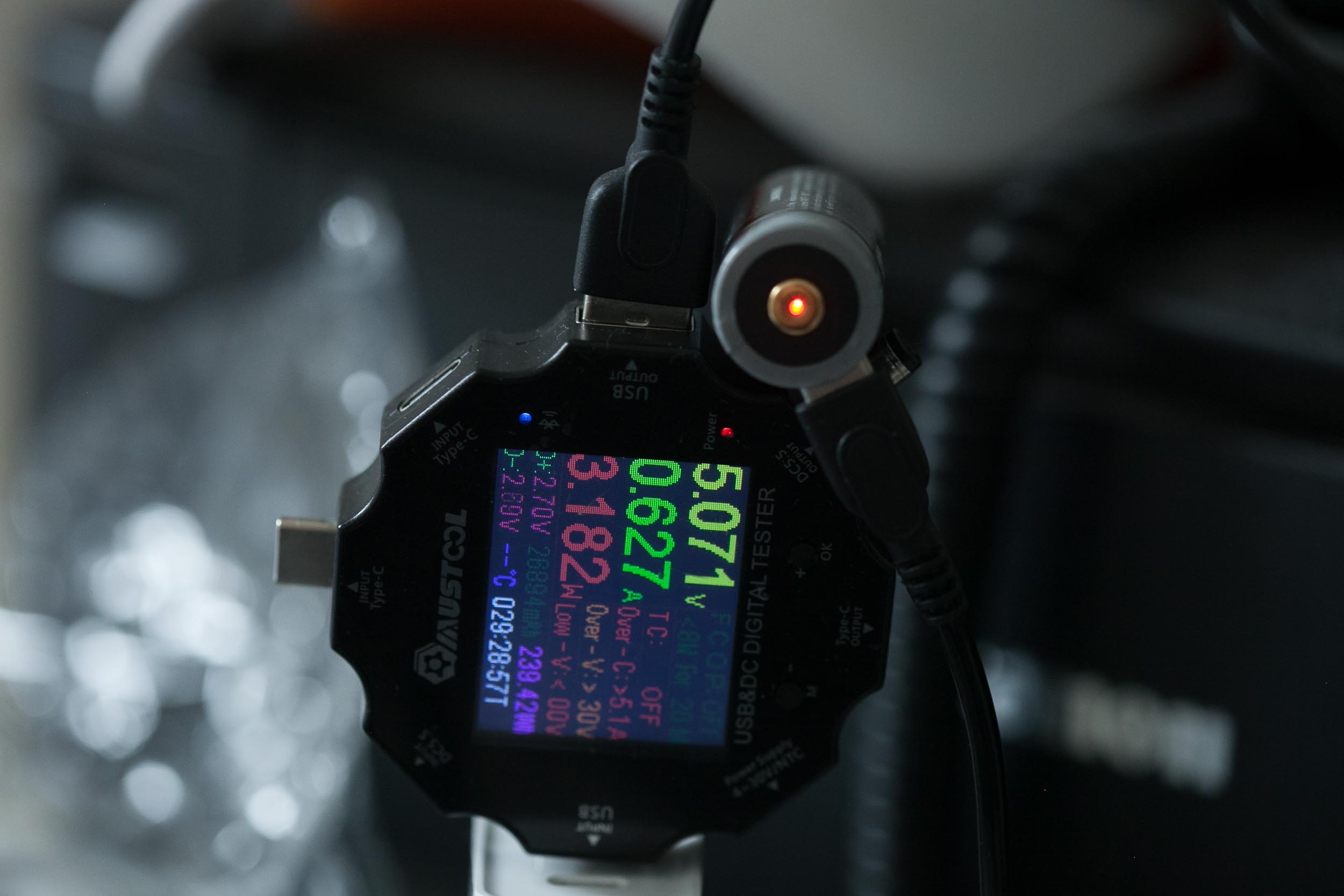
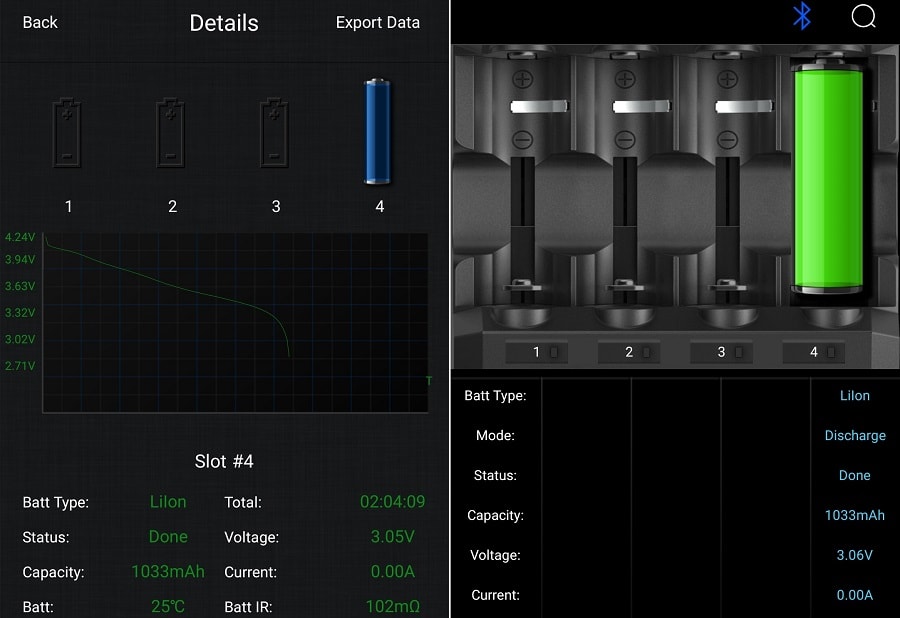
Performance test
This is the gear I used for testing:
| Gear | Purpose | Link to buy |
|---|---|---|
| Hagner E4-X | Measuring beam intensity (throw) | Inquire at Hagner.se |
| Extech SDL400 | Lumens and logging runtimes | Amazon.com, Amazon.co.uk, |
| Leica Disto D2 | Distance for throw measurements | Amazon.com, Amazon.co.uk, |
| Asensetek Lighting Passport Pro Standard | Spectrometer for LED measurements | – |
Lumen measurements:
The output measurements in this review are based on my homemade integrating spheres, each equipped with an Extech SDL400 Lux Meter. For consistency and accuracy, a calibration light (Convoy S2+ with 249lm and a Convoy S2+ with 261lm) is measured prior to each set of lumen measurements.
For high-output lights, one of the lux meters uses an ND camera filter to prevent the lux meter to max out. This is either the Kenko PRO1D ND16 up till about 80,000 lumens or Gobe ND32 for anything above.
All of my readings were taken from a fully-charged Loop 1100mAh battery.
The measurements were taken manually at turn on and 30 seconds. The 10-minute numbers are taken from the runtime graph.
| Mode | Specs | at turn on | 30 sec | 10 minutes |
|---|---|---|---|---|
| Eco | 10 lm | 0 | 0 | 0 |
| Low | 100 lm | 22 lm | 25 lm | 30 lm |
| High* | 450 lm | 91 lm | 90 lm | 86 lm |
| Turbo | 910 lm | 465 lm | 265 lm | 145 lm |
Low and High increase output from the start, so I wrote down the highest number for High I could see, so this is not exactly the number you see at turn-on, but after a few seconds.
But boy, I don’t get close to the 910 lumens it claims, but I guess I got the 450-lumen version. It’s interesting to note that the manual I received had the 910-lumen specifications, and I can’t seem to find the 450-lumen specifications. Therefore I just left the 910 specs in the table above.
LOOP SK01s Battery life and runtime
The runtime test was done with the 50cm home made integrating sphere, combined with the Extech SDL400 data logging Lux Meter.
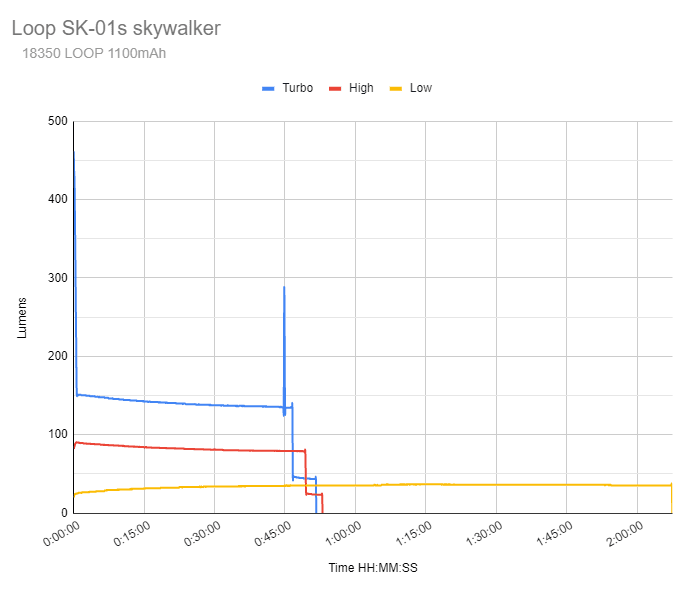
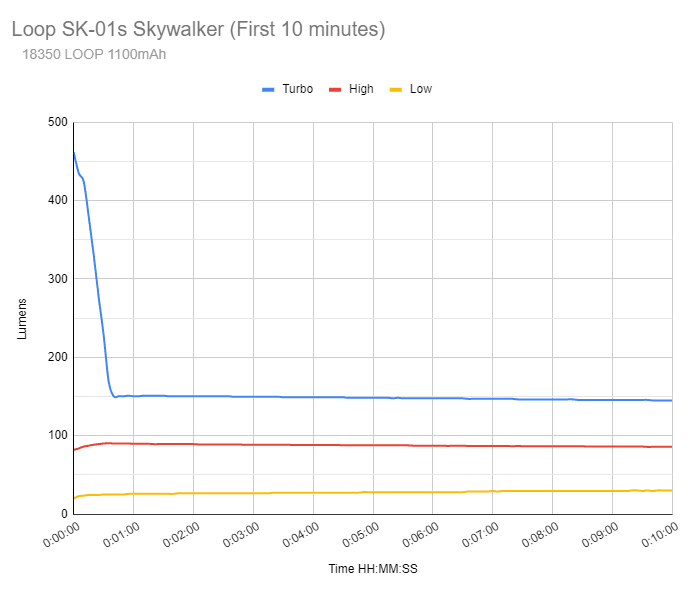
| Mode | Specified | Measured runtime (ANSI FL1) | Time till shut off |
|---|---|---|---|
| Eco | 8h | – | – |
| Low | 3h | 2h 07min | 2h 07min |
| High | 1h 05min | 53min | 53min |
| Turbo | 30sec + 1h | 47min | 51min |
Strange spike in Turbo before it drops down, and none of the specified runtimes are met.
Also, the output increases within the first few seconds of turning it on. This is not very visible in the graph for Turbo mode, because it’s plotted at 5 seconds, but it’s visible for High and Low.
The eco mode couldn’t be measured with the same setup I used for the other modes.. And honestly, Eco mode is so low that you can’t really use it for anything useful.
About ANSI FL1 standards: The runtime is measured until the light drops to 10% of its initial output (30 seconds after turning on). This does not mean that the flashlight is not usable anymore. The last column shows how long the light actually works till it shuts off. If there is a + symbol, it means that the test was stopped at that particular point, but the light was actually still running. This happens on certain occasions, with certain drivers, firmware, or batteries.
LOOP SK01s Peak beam intensity and beam distance measurements
Measurements were taken with a Hagner E4-X Lux Meter, measured at 5 meters indoors and 20 meter outdoors.
| Mode | Specified | Candelas measured | meters | yards |
|---|---|---|---|---|
| Eco | – | 125 cd | 22 m | 24 yd |
| Low | – | 40,125 cd | 401 m | 438 yd |
| High | – | 212,500 cd | 922 m | 1008 yd |
| Turbo | 1600m / 640,000 cd | 350,000 cd | 1183 m | 1294 yd |
| Turbo (start) | – | 610,000 cd | 1562 m | 1708 yd |
I added the highest readings with the 5-meter measurement, because I can see the actual display while testing. At 20 meters I have to walk to see the numbers, and therefore can’t measure the highest measurements at turn on (or soon after turn on). At turn on, it almost reached the claimed 640,000 cd at 5 meters, so it’s pretty close.
My 20-meter measurements were even lower at 324,000 cd in Turbo, and Low, so I just shared my 5-meter measurements to give my highest measurements. I’m not too thrilled with this performance even though 1000 yards is not bad for high mode.
It is clear that Loop Universe is not following the ANSI FL1 standards because after 30 seconds it almost halved the candela readings.
About peak beam intensity: Peak beam distance according to ANSI FL1 standards: The calculated value of distance in meters at which the flashlight produces a light intensity of 0.25 lux. (0.25 lux is about the brightness of a full moon shining on an object). The columns ‘Meters’ and ‘Yards’ use rounded numbers.
Beamshots
For the tower beamshots, I used a Canon EOS 5D mk2 with a 100mm lens. Manual settings: ISO1600, 0.5sec, F4, 5000K
The tower is about 450 meters / 492 yards away.
For the beamshots at the shed and reflective fence, I used a Canon EOS 5D Mk2 with a 50mm lens. Manual settings: ISO1600, 1/4sec, F4, 5000K
The shed is about 65 meters / 71 yards away, and the reflective fence is about 200 meters.
Compared to the following flashlights:
- Lumintop Thor 1
- Lumintop Thor 2
- Lumintop Thor 4

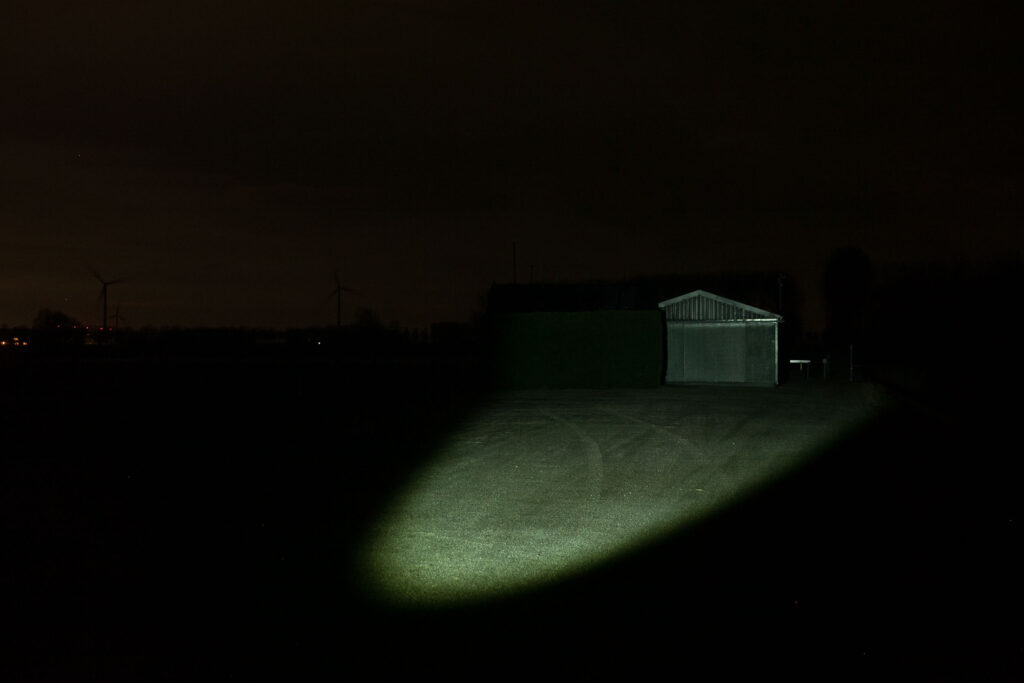
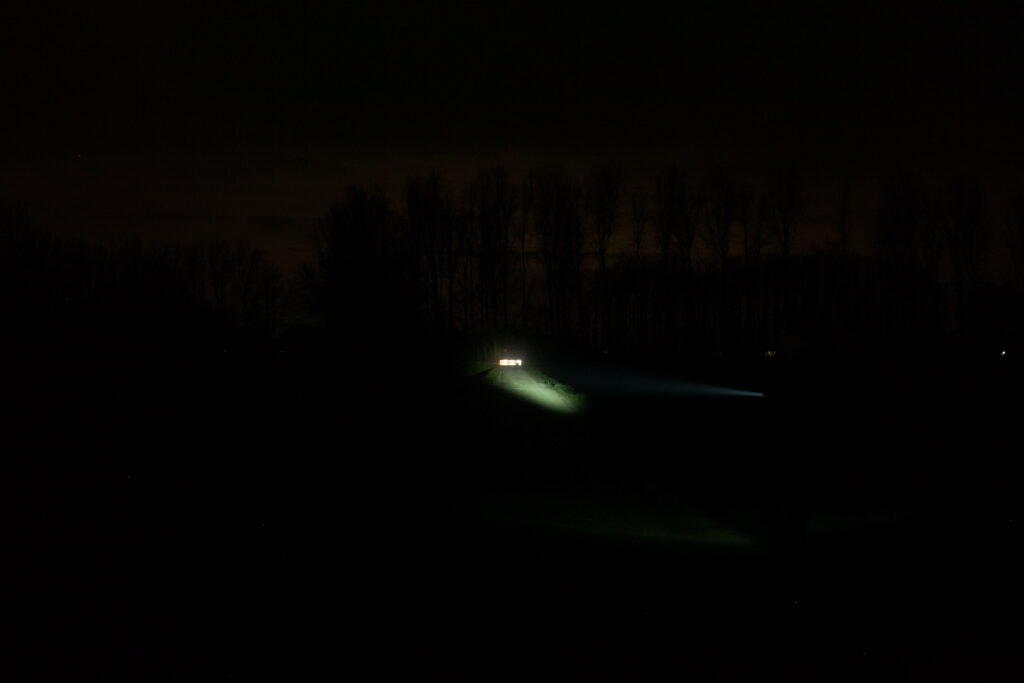
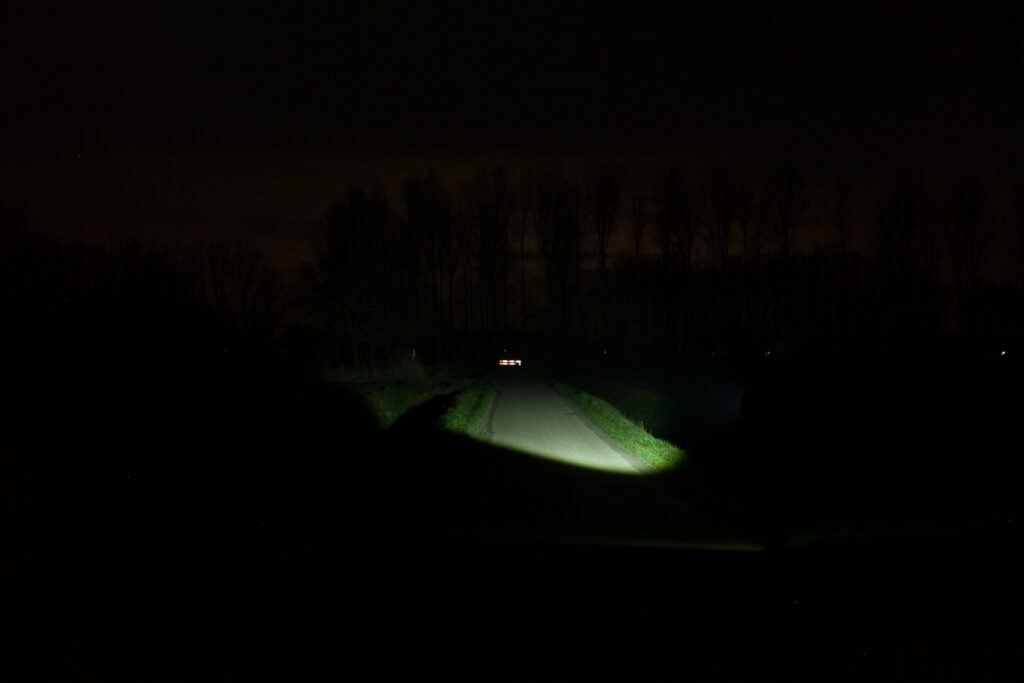
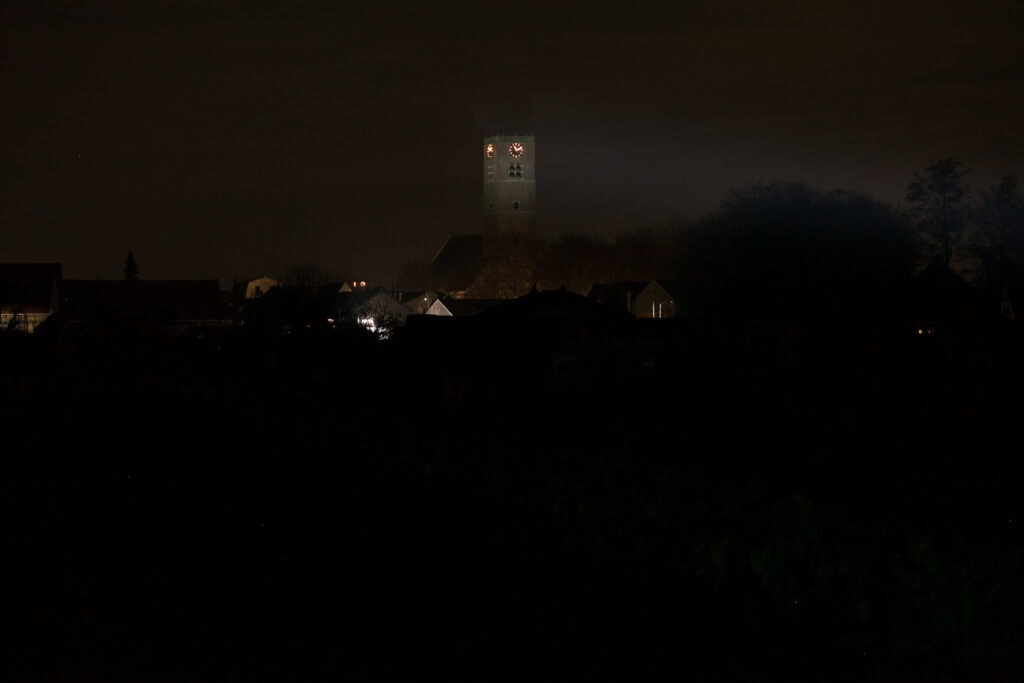
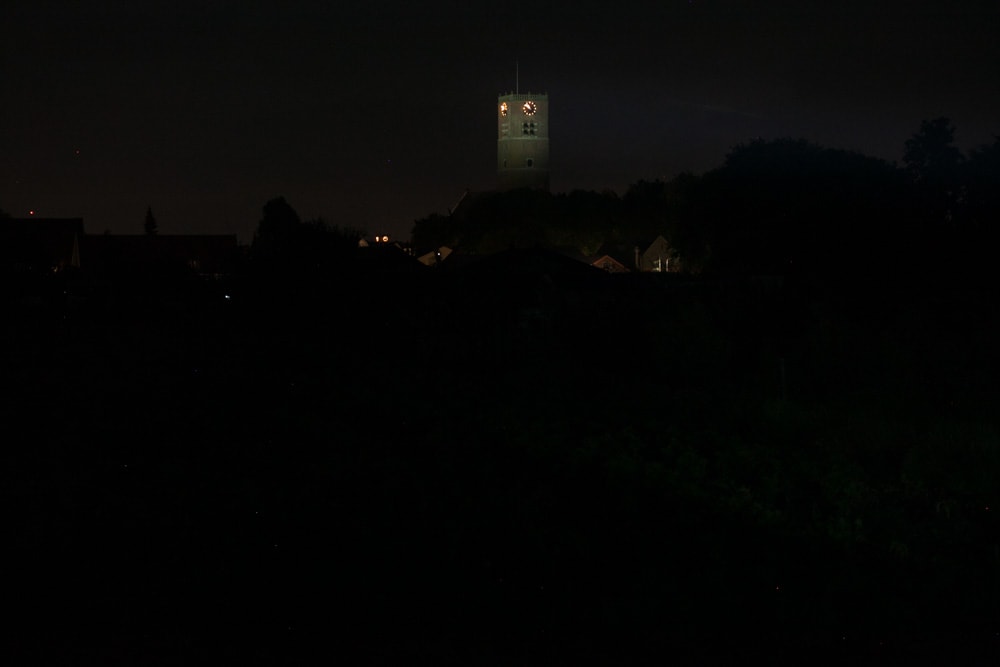
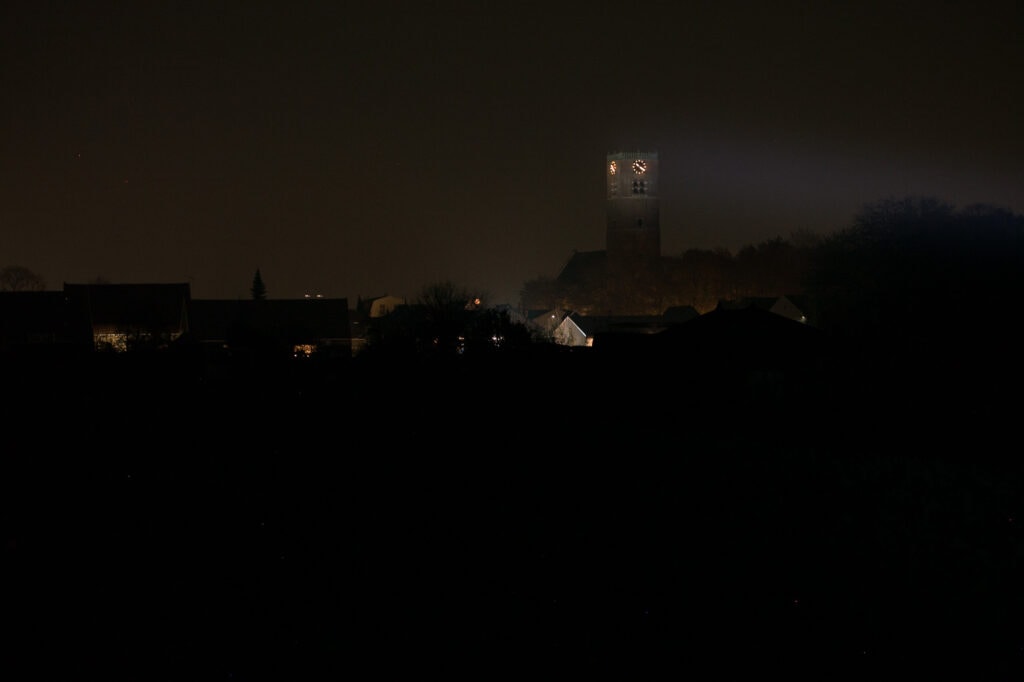
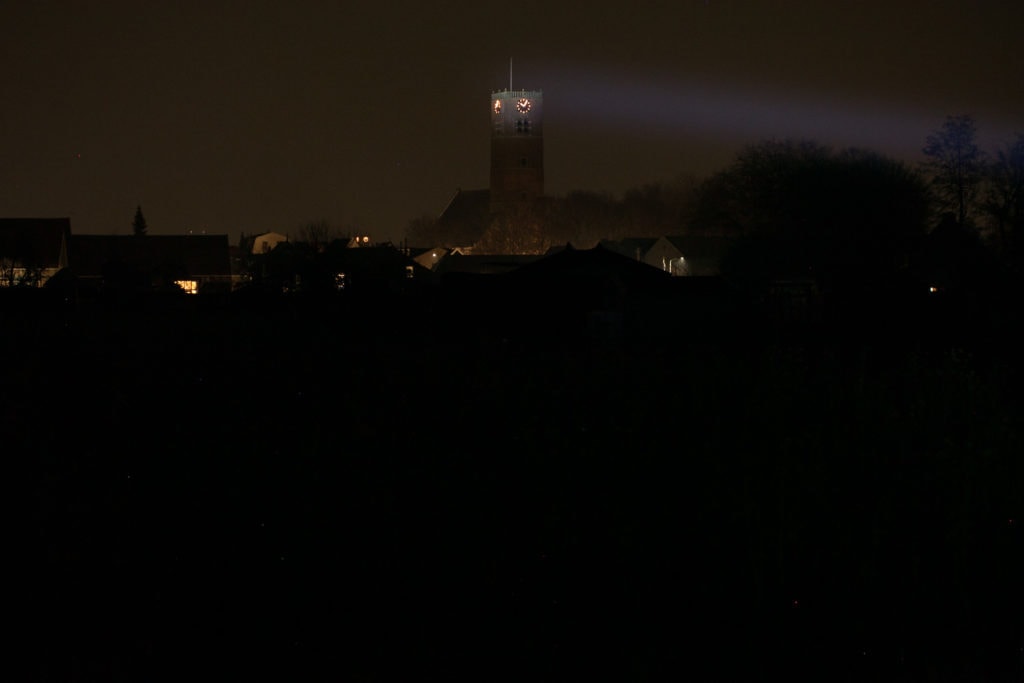
Keep in mind that the 450 meters shot is directly after turning on.. it will drop very quickly, so this is just to show the ‘beam quality’ and not so much of its performance.
Disclaimer: This flashlight was sent to me for review at no cost by Nealsgadgets. I have not been paid to review, nor have I been holding back on problems or defects.
Final Verdict
Pros
- Shortest zoomable LEP flashlight at the time of writing this review
- 4 ways to relieve your stress (2 spinners, the zoom ring, and the bolt action).
- Very unique design
- Impressive as the first flashlight sold under the name Loop Universe.
- LEP with a zoom mechanism
- Includes a USB-C rechargeable 18350 battery
Cons
- Eco mode is too low for an LEP
- Exaggerated lumen claims
- Can’t deactivate the lights in the tail (when the light is turned on)
- No protective glass lens in front of the convex lens, so it can be damaged easily
- Turbo mode’s output drops very quickly for an LEP flashlight. Overal performance not very good.
Explanation on star ratings:
1: Avoid: my phone flashlight would be a better choice – 2: Poor: significant defect or issues; almost unusable – 3: Average: some defects or issues; but still usable 4: Good: recommended (minor issues) – 5: Great: highly recommended

It’s hard to give just 1 rating for this light because it depends on what the use case is.
It’s cool to have a zoomable LEP flashlight with 4 modes, but Eco mode is too low, and not very useful for an LEP, but that’s my personal opinion. Turbo mode drops very quickly, but still throws over 1000 yards after the drop. well as in high mode, which is still impressive for such a small light, compared to an LED flashlight.
If you’d come from the flashlight aspect of this light, with the fidgets as a secondary thing, it wouldn’t score very high and is likely around 3 stars. It doesn’t compete in any aspect with other LEP flashlights.
If the fidgets are the main aspect, it’s still a pretty interesting light. I’d probably give it 5 stars for being a fidget toy flashlight with an interesting light source.
Buy your LOOP SK01s here
Get 25% off with our unique coupon code at Nealsgadgets: 1LumenLEP
1lumen selects and reviews products personally. We may earn affiliate commissions through our links, which help support our testing.